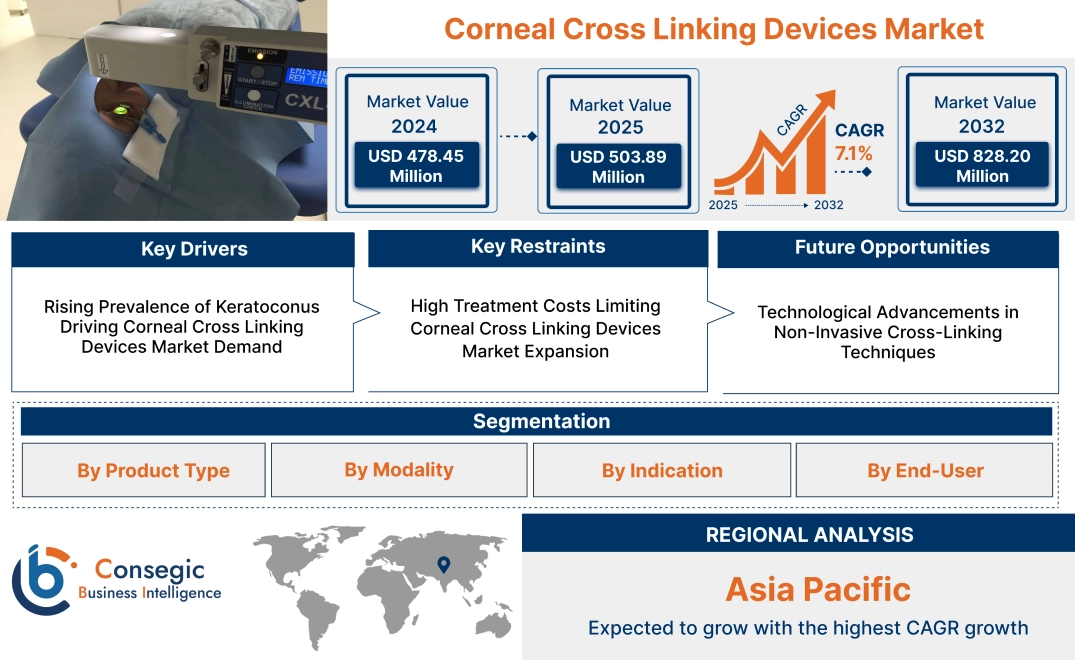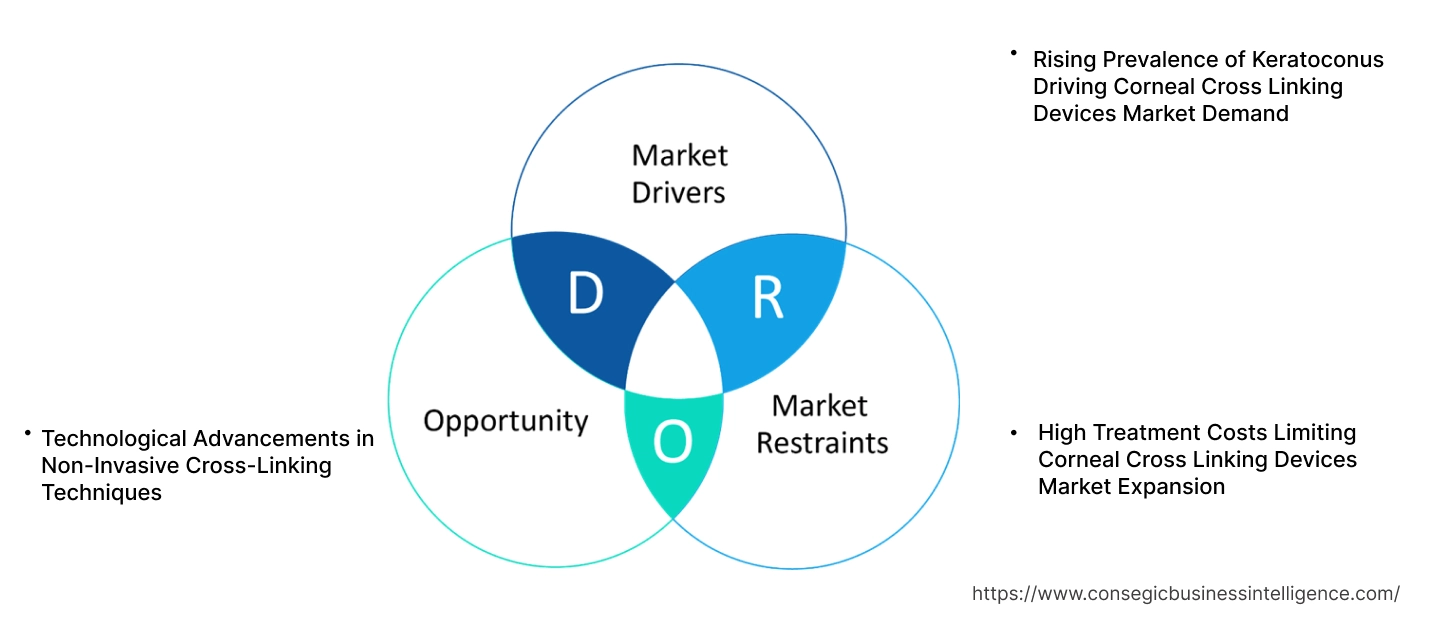Corneal Cross Linking Devices Market Size:
Corneal Cross Linking Devices Market size is estimated to reach over USD 828.20 Million by 2032 from a value of USD 478.45 Million in 2024 and is projected to grow by USD 503.89 Million in 2025, growing at a CAGR of 7.1% from 2025 to 2032.
Corneal Cross Linking Devices Market Scope & Overview:
Corneal cross-linking (CXL) devices are medical devices used to treat corneal diseases, particularly keratoconus. These devices utilize ultraviolet light and riboflavin to strengthen corneal tissue, improving vision and halting disease progression. The devices feature controlled UV light exposure, ensuring precise treatment for enhanced effectiveness. Benefits include improved corneal stability, reduced risk of vision impairment, and minimized need for corneal transplants.
Applications include use in ophthalmology clinics, hospitals, and specialized eye care centers. These devices are essential for treating corneal ectasia, progressive keratoconus, and other degenerative corneal conditions. End-use industries include healthcare, specifically ophthalmology, where improving eye care procedures and maintaining corneal health is crucial. Research institutions also contribute to the development of advanced treatment techniques.
Corneal Cross Linking Devices Market Dynamics - (DRO) :
Key Drivers:
Rising Prevalence of Keratoconus Driving Corneal Cross Linking Devices Market Demand
Keratoconus is a progressive eye disorder that causes the cornea to thin and bulge into a cone shape, leading to visual impairment. Corneal cross-linking (CXL) is an effective treatment for halting the progression of this condition by strengthening the corneal tissue. As the global prevalence of keratoconus increases, the demand for corneal cross-linking devices rises, driving corneal cross linking devices market growth.
For instance, studies show that CXL significantly improves vision and halts the deterioration of corneal structure in patients with keratoconus. As awareness of the benefits of this procedure grows and more patients seek out treatment options, the market for corneal cross-linking devices expands.
Therefore, the increasing prevalence of keratoconus serves as a primary driver for the corneal cross linking devices market growth.
Key Restraints:
High Treatment Costs Limiting Corneal Cross Linking Devices Market Expansion
The cost of corneal cross-linking procedures remains a significant barrier to widespread adoption. These treatments, which require advanced technology and skilled professionals, often come with high upfront costs for both patients and healthcare providers. Additionally, the procedure may not always be covered by insurance in certain regions, making it inaccessible to a broader population.
This financial burden limits the accessibility of corneal cross-linking treatments, particularly in developing countries or for individuals without sufficient insurance coverage. As a result, the high costs associated with these devices and treatments hinder the corneal cross linking devices market expansion.
Future Opportunities :
Technological Advancements in Non-Invasive Cross-Linking Techniques
The development of non-invasive or minimally invasive corneal cross-linking techniques presents significant corneal cross linking devices market opportunities for the future. New technologies aim to reduce the need for physical corneal abrasion or chemical application, making the procedure less uncomfortable and safer for patients.
For example, researchers are exploring the use of ultraviolet light in combination with riboflavin in a more refined, non-invasive manner that could improve the treatment’s accessibility and success rate. As these innovations mature, they are expected to drive the adoption of corneal cross-linking devices.
Therefore, the advancement of non-invasive corneal cross-linking techniques offers a promising opportunity for corneal cross linking devices market trend and the wider adoption of these devices.
Corneal Cross Linking Devices Market Segmental Analysis :
By Product Type:
Based on product type, the market is segmented into Riboflavin Solutions (Isotonic Riboflavin, Hypo-Osmolar Riboflavin) and Corneal Cross-Linking Systems.
The Riboflavin Solutions segment accounted for the largest revenue in corneal cross linking devices market share in 2024.
- Riboflavin solutions are critical in corneal cross-linking procedures, facilitating the strengthening of corneal tissue in patients with conditions like keratoconus and corneal ectasia.
- These solutions are commonly used alongside ultraviolet (UV) light to enhance the collagen fibers in the cornea, preventing further degeneration and preserving vision.
- The widespread adoption of riboflavin solutions across hospitals and ophthalmic clinics, especially in regions with high incidences of keratoconus, contributes to the dominant revenue share.
- Furthermore, advancements in riboflavin formulations, such as hypo-osmolar variants, have enhanced treatment efficacy and patient outcomes, leading to significant corneal cross linking devices market
- Therefore, according to corneal cross linking devices market analysis, riboflavin solutions remain essential in the treatment of corneal conditions, driving the corneal cross linking devices market
The Corneal Cross-Linking Systems segment is anticipated to register the fastest CAGR during the forecast period.
- Corneal cross-linking systems are used to deliver UV light to the cornea in conjunction with riboflavin solutions, a crucial step in strengthening the corneal tissue.
- Technological advancements, such as the development of more efficient and portable systems, are driving the adoption of these devices in clinical settings.
- These systems are particularly valuable in improving the precision and consistency of treatment, leading to better patient outcomes.
- As more ophthalmic clinics and ambulatory surgical centers incorporate advanced corneal cross-linking systems into their practices, this segment is expected to experience a rapid trend.
- Therefore, according to corneal cross linking devices market analysis, the increasing use of cutting-edge corneal cross-linking systems to treat a wide range of corneal conditions contributes significantly to the market’s expansion.
By Modality:
Based on modality, the market is segmented into the Epithelium-Off Technique and Epithelium-On Technique.
The Epithelium-Off Technique accounted for the largest revenue in corneal cross linking devices market share in 2024.
- The Epithelium-Off Technique involves removing the corneal epithelium before applying riboflavin and UV light.
- This method has been widely used due to its proven effectiveness in treating conditions like keratoconus, as it allows better penetration of riboflavin into the corneal stroma.
- The success and long-term stability of this technique have led to its continued dominance in clinical practice.
- Additionally, with its established safety and efficacy profile, the Epithelium-Off Technique remains the preferred choice for ophthalmologists in treating moderate to advanced cases of corneal conditions.
- Therefore, according to market analysis, this technique's long-standing use and favorable outcomes contribute to its dominant position in the corneal cross-linking devices market.
The Epithelium-On Technique is anticipated to register the fastest CAGR during the forecast period.
- The Epithelium-On Technique, which preserves the corneal epithelium, is gaining popularity due to its reduced discomfort and faster recovery time for patients.
- This technique is particularly advantageous for patients with thin corneas or those with concerns about the healing process post-surgery.
- As advancements continue in technology and clinical techniques, the Epithelium-On method is expected to see wider adoption, especially in outpatient and minimally invasive settings.
- Thus, according to market analysis, given its patient-friendly benefits, this technique is poised to experience the fastest trend in the coming years, contributing to the overall expansion of the market.
By Indication:
Based on indication, the market is segmented into Keratoconus, Corneal Ectasia, Infectious Keratitis, and Pellucid Marginal Degeneration.
The Keratoconus segment accounted for the largest revenue share in 2024.
- Keratoconus is one of the most common conditions treated with corneal cross-linking, characterized by the thinning and bulging of the cornea.
- The increasing prevalence of keratoconus worldwide, especially in young adults, is a significant factor driving demand for corneal cross-linking procedures.
- This procedure stabilizes the cornea, reducing the progression of the disease and preserving vision, making it the most prevalent indication for corneal cross-linking.
- Therefore, according to market analysis, the effectiveness of the procedure in preventing corneal transplants further reinforces its importance in treating keratoconus, ensuring continued market trend.
The Corneal Ectasia segment is expected to register the fastest CAGR during the forecast period.
- Corneal Ectasia, a condition characterized by the thinning of the cornea following refractive surgeries like LASIK, is an emerging indication for corneal cross-linking.
- With the increasing number of LASIK surgeries globally, the incidence of post-surgical corneal ectasia is rising, subsequently driving demand for cross-linking treatments.
- This condition’s rising prevalence and the growing awareness of cross-linking as an effective solution are expected to result in significant corneal cross linking devices market trends for this indication.
- Therefore, according to market analysis, as the awareness and application of cross-linking procedures in corneal ectasia increase, this segment will witness a rapid trend in the coming years.
By End User:
Based on end-users, the market is segmented into Hospitals, Ophthalmic Clinics, and Ambulatory Surgical Centers.
The Hospitals segment accounted for the largest revenue share by 48.60% in 2024.
- Hospitals are the primary healthcare providers for severe corneal conditions, including keratoconus and corneal ectasia, due to their advanced infrastructure and medical resources.
- The demand for corneal cross-linking devices in hospitals is driven by the need for specialized care, advanced surgical interventions, and post-operative monitoring.
- Hospitals are also preferred by patients for complex treatments, which contributes to their leading role in the market.
- Therefore, according to market analysis, with the availability of skilled professionals and the high volume of patients, hospitals continue to dominate the corneal cross-linking devices market.
The Ambulatory Surgical Centers segment is anticipated to register the fastest CAGR during the forecast period.
- Ambulatory Surgical Centers (ASCs) are gaining popularity due to their cost-effectiveness, shorter recovery times, and ability to perform minimally invasive procedures.
- These centers offer the convenience of outpatient care, making them an attractive option for patients seeking quick and efficient treatments.
- With increasing numbers of cataract and corneal cross-linking surgeries being performed in ASCs, this segment is expected to experience the fastest trend, especially in developed markets.
- Thus, according to market analysis, the focus on patient convenience and cost savings will drive the adoption of corneal cross-linking procedures in ASCs, fueling market expansion.
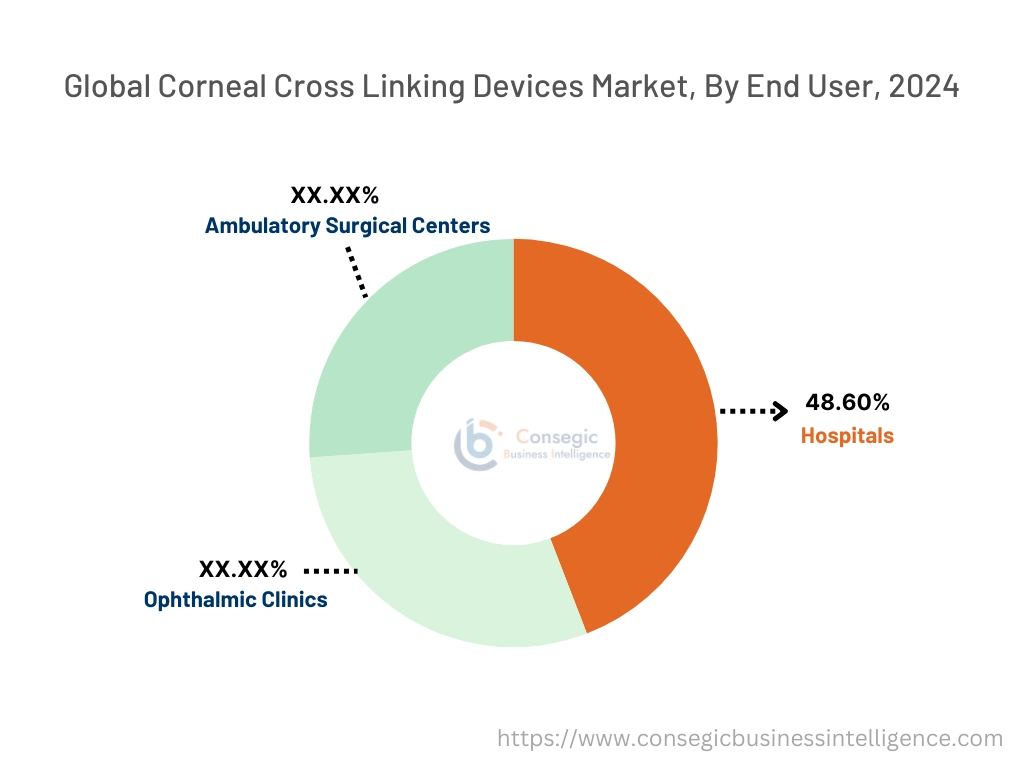
Regional Analysis:
The regional segment includes North America, Europe, Asia Pacific, Middle East and Africa, and Latin America.
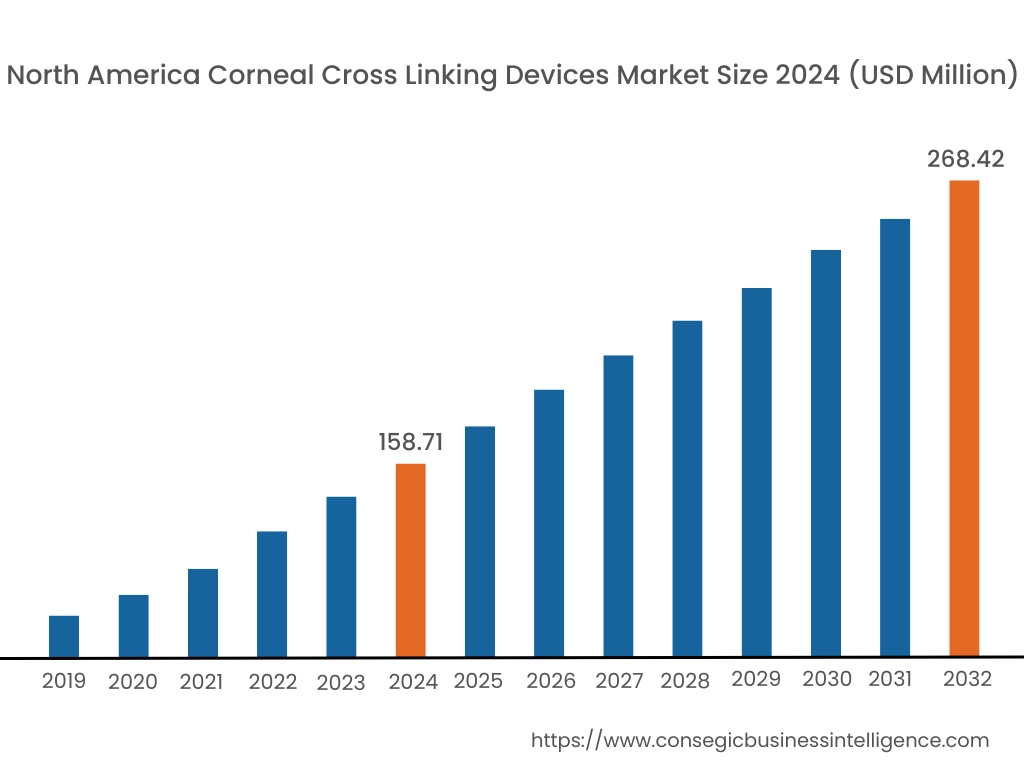
In 2024, North America was valued at USD 158.71 Million and is expected to reach USD 268.42 Million in 2032. In North America, the U.S. accounted for the highest share of 72.90% during the base year of 2024. North America holds a significant share of the corneal cross-linking devices market due to advanced healthcare infrastructure and increasing awareness about eye care. The United States dominates the region with high adoption of corneal cross-linking treatments, especially for conditions like keratoconus and corneal ectasia. The presence of key market players, coupled with ongoing research and development, contributes to the market's growth. The region also benefits from favorable reimbursement policies and an established network of ophthalmic clinics and hospitals offering these treatments. As the prevalence of corneal disorders continues to rise, the demand for corneal cross-linking devices in North America is expected to remain robust.
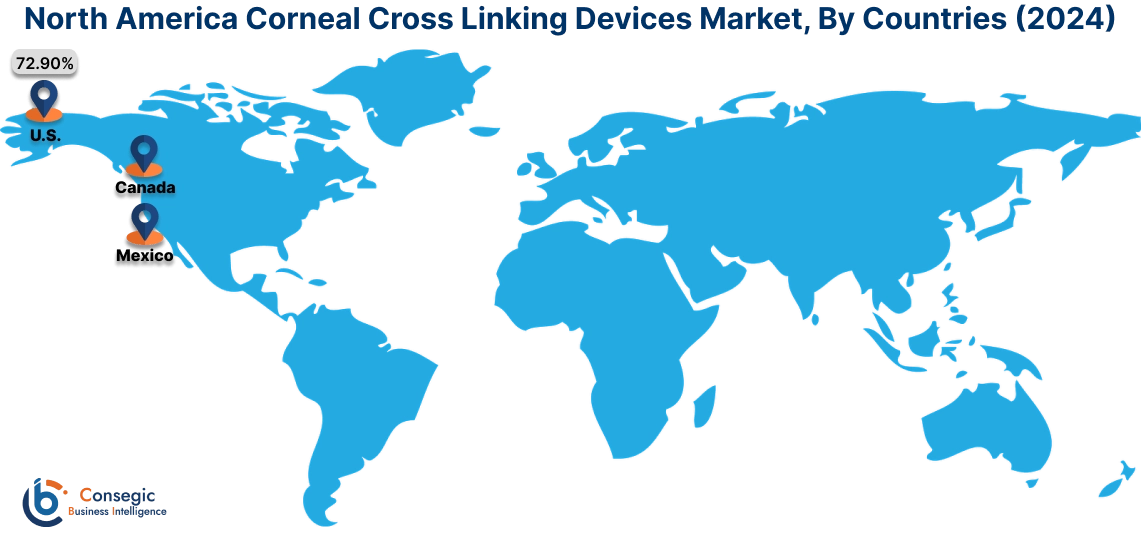
In Asia Pacific, the market is experiencing the fastest growth with a CAGR of 7.5% over the forecast period. The Asia-Pacific region is experiencing rapid market expansion, driven by rising healthcare investments and the increasing prevalence of eye disorders. Countries like China, Japan, and India are witnessing an uptick in demand for corneal cross-linking devices. Growing awareness about eye health and the availability of advanced medical treatments are key factors fueling the market. The region also benefits from the increasing number of ophthalmic clinics and surgical centers offering corneal cross-linking procedures. While the adoption rate is still catching up in North America and Europe, the expanding healthcare sector and rising patient awareness suggest significant potential for growth.
Europe also represents a major market for corneal cross-linking devices, driven by increasing incidence rates of corneal diseases and technological advancements in cross-linking systems. Germany, the UK, and France are among the leading countries in this region, with a strong emphasis on innovative healthcare solutions. Regulatory approvals and reimbursement policies for corneal cross-linking treatments have fostered the market’s expansion. European ophthalmic clinics are widely adopting these technologies due to their proven efficacy in treating keratoconus. The region is poised for steady growth, with significant investments in research and awareness campaigns for corneal health.
The Middle East and Africa (MEA) region shows a modest yet steady growth in the corneal cross-linking devices market. Countries such as the UAE and Saudi Arabia are witnessing improved healthcare facilities, with more ophthalmic clinics providing corneal cross-linking treatments. However, the market is still developing, with many areas lacking awareness about the benefits of these treatments. The rising prevalence of corneal diseases and an increasing focus on healthcare infrastructure in the region are expected to drive the demand for corneal cross-linking devices in the coming years. International partnerships and the entry of global players into the region may further accelerate market growth.
The Latin American market for corneal cross-linking devices is in the early stages of adoption but is poised for growth. Brazil and Mexico are key markets in the region, benefiting from a growing middle class and improved healthcare accessibility. However, challenges such as limited awareness about advanced eye care treatments and the availability of trained professionals remain. The rising burden of keratoconus and corneal ectasia in the region is expected to drive demand for these devices. As healthcare systems improve and awareness campaigns are introduced, Latin America’s market for corneal cross-linking devices is expected to experience gradual expansion in the coming years.
Top Key Players and Market Share Insights:
The Global Corneal Cross Linking Devices Market is highly competitive with major players providing products and services to the national and international markets. Key players are adopting several strategies in research and development (R&D), product innovation, and end-user launches to hold a strong position in the Global Corneal Cross Linking Devices Market. Key players in the Corneal Cross Linking Devices industry include-
- Avedro Inc. (United States)
- Peschke Meditech GmbH (Germany)
- Santen Pharmaceutical Co., Ltd. (Japan)
- Katalyst Surgical (United States)
- EyeTechCare (France)
- Beaver-Visitec International (United States)
- TrueVision Systems, Inc. (United States)
- Oculus Optikgeräte GmbH (Germany)
- Corneal Health (United States)
- Medio Lab (Italy)
Recent Industry Developments:
Mergers and Acquisitions:
- In July 2024, Bausch + Lomb acquired Trukera Medical, a U.S.-based ophthalmic medical diagnostic company specializing in point-of-care devices for measuring tear osmolarity. This acquisition aimed to strengthen Bausch + Lomb's presence in the dry eye market.
Corneal Cross Linking Devices Market Report Insights :
| Report Attributes | Report Details |
| Study Timeline | 2019-2032 |
| Market Size in 2032 | USD 828.20 Million |
| CAGR (2025-2032) | 7.1% |
| By Product Type |
|
| By Modality |
|
| By Indication |
|
| By End User |
|
| By Region |
|
| Key Players |
|
| North America | U.S. Canada Mexico |
| Europe | U.K. Germany France Spain Italy Russia Benelux Rest of Europe |
| APAC | China South Korea Japan India Australia ASEAN Rest of Asia-Pacific |
| Middle East and Africa | GCC Turkey South Africa Rest of MEA |
| LATAM | Brazil Argentina Chile Rest of LATAM |
| Report Coverage |
|
Key Questions Answered in the Report
How big is the Corneal Cross Linking Devices Market? +
In 2024, the Corneal Cross Linking Devices Market was USD 478.45 million.
What will be the potential market valuation for the Corneal Cross Linking Devices Market by 2032? +
In 2032, the market size of the Corneal Cross Linking Devices Market is expected to reach USD 828.20 million.
What are the segments covered in the Corneal Cross Linking Devices Market report? +
The product type, modality, indication, and end-user are the segments covered in this report.
Who are the major players in the Corneal Cross Linking Devices Market? +
Avedro Inc. (United States), Peschke Meditech GmbH (Germany), Beaver-Visitec International (United States), TrueVision Systems, Inc. (United States), Oculus Optikgeräte GmbH (Germany), Corneal Health (United States), Medio Lab (Italy), Santen Pharmaceutical Co., Ltd. (Japan), Katalyst Surgical (United States), EyeTechCare (France) are the major players in the Corneal Cross Linking Devices market.
